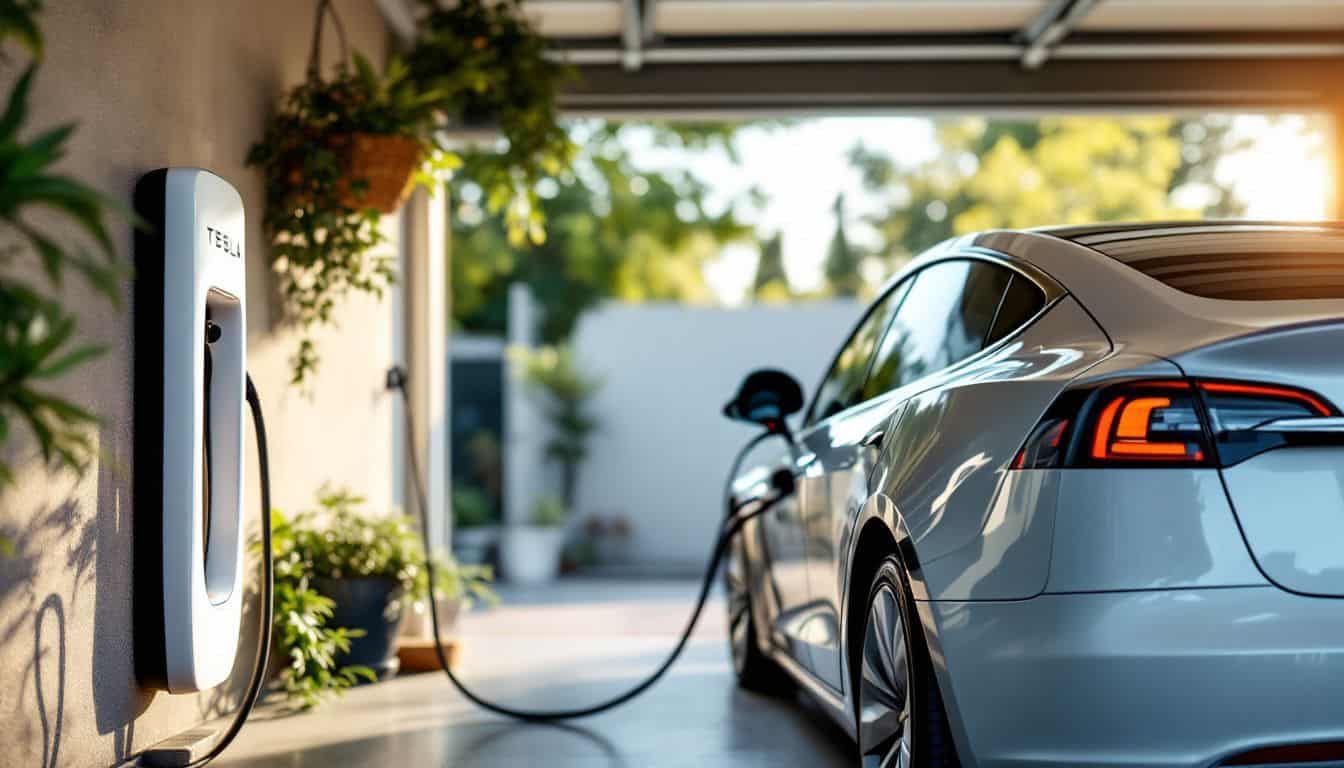Ever wondered how much it costs to charge a Tesla? You’re not alone. Many EV owners grapple with this question. Here’s a surprising fact: charging a Tesla is over three times cheaper per mile than fueling a gas car.
This article will break down the real costs of charging your Tesla – from home setups to Superchargers. Ready for some shocking truths about EV costs?
Key Takeaways
Charging a Tesla costs about 3–4 cents per mile, compared to 10–15 cents for gas cars.
Home charging is cheapest, adding around $50 to monthly electric bills. Superchargers cost more at $0.25-$0.50 per kilowatt-hour.
Tesla owners can save $7,000-$11,000 on fuel costs over 7 years compared to gas vehicles.
Charging costs vary by model: Model 3 is cheapest at 4.03 cents per mile, while Model X costs 5.17 cents per mile.
Free charging is available at some hotels, workplaces, and malls. Tesla’s Destination Charging program has over 40,000 free chargers.
Table of Contents
Tesla Charging Options Overview
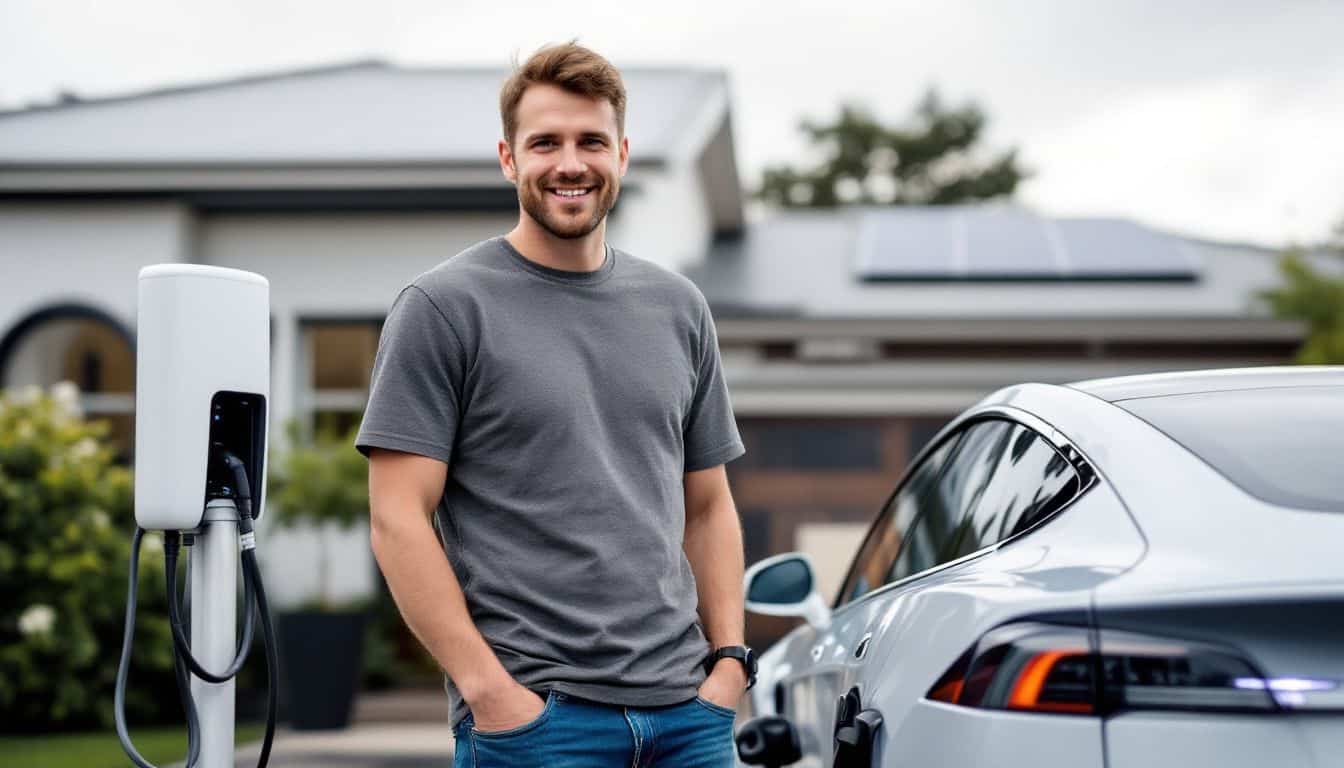
Tesla’s got you covered for charging your ride. Home setups, speedy Superchargers – there’s a way to power up that fits your lifestyle.
Home Charging Solutions

Home charging is a game-changer for Tesla owners – like having your own mini gas station right in your garage! You’ll need a 240-volt charging station, costing between $1,150 and $2,750.
Installation can run $800 to $2,000, or more in some cases. But here’s the good news: once it’s set up, you’ll only see about a $50 bump in your monthly electric bill.
I got my Tesla Model 3 on lease. Setting up home charging seemed challenging, but it was so worth it! Now, I wake up every morning to a fully charged car.
It’s like magic – plug in at night, and voila! Full “tank” by sunrise. No more rushing to charge before work or searching for stations on road trips. Trust me, ladies, it’s a total life-saver!
Tesla Supercharging Network
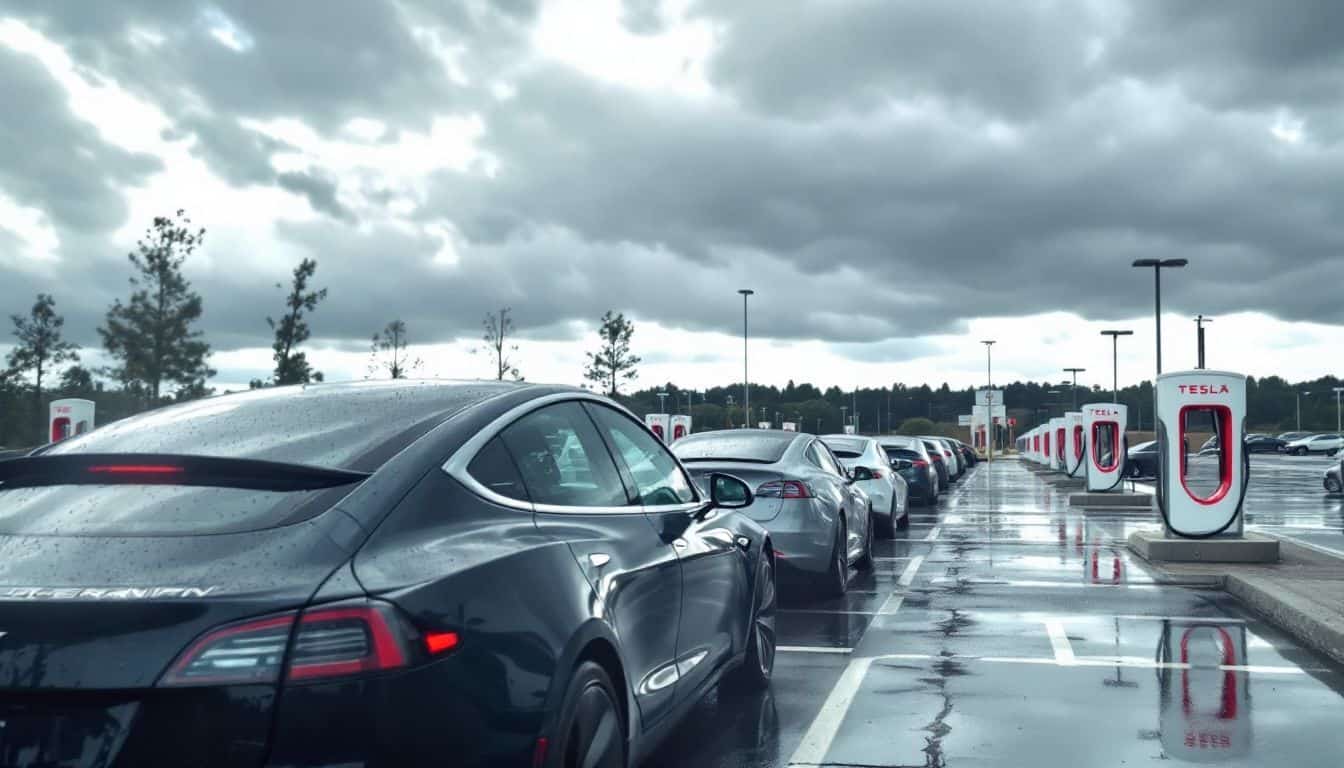
Moving from home charging, let’s talk about Tesla’s superstar network. Tesla’s Supercharger stations are like fast-food drive-thrus for your car’s battery. They’re quick, easy, and all over the place.
With over 20,000 charging spots at more than 2,100 stations worldwide, you’re never far from a power-up.
These super-fast chargers can juice up your Tesla in a flash. In just 15 minutes, you can add up to 200 miles of range. That’s enough time to grab a coffee and stretch your legs. The cost? It varies, but expect to pay between $0.25 and $0.50 per kilowatt-hour.
It’s pricier than charging at home, but way cheaper than filling up a gas tank. Plus, it’s perfect for those long road trips when you need a quick boost.
Third-party Charging Opportunities
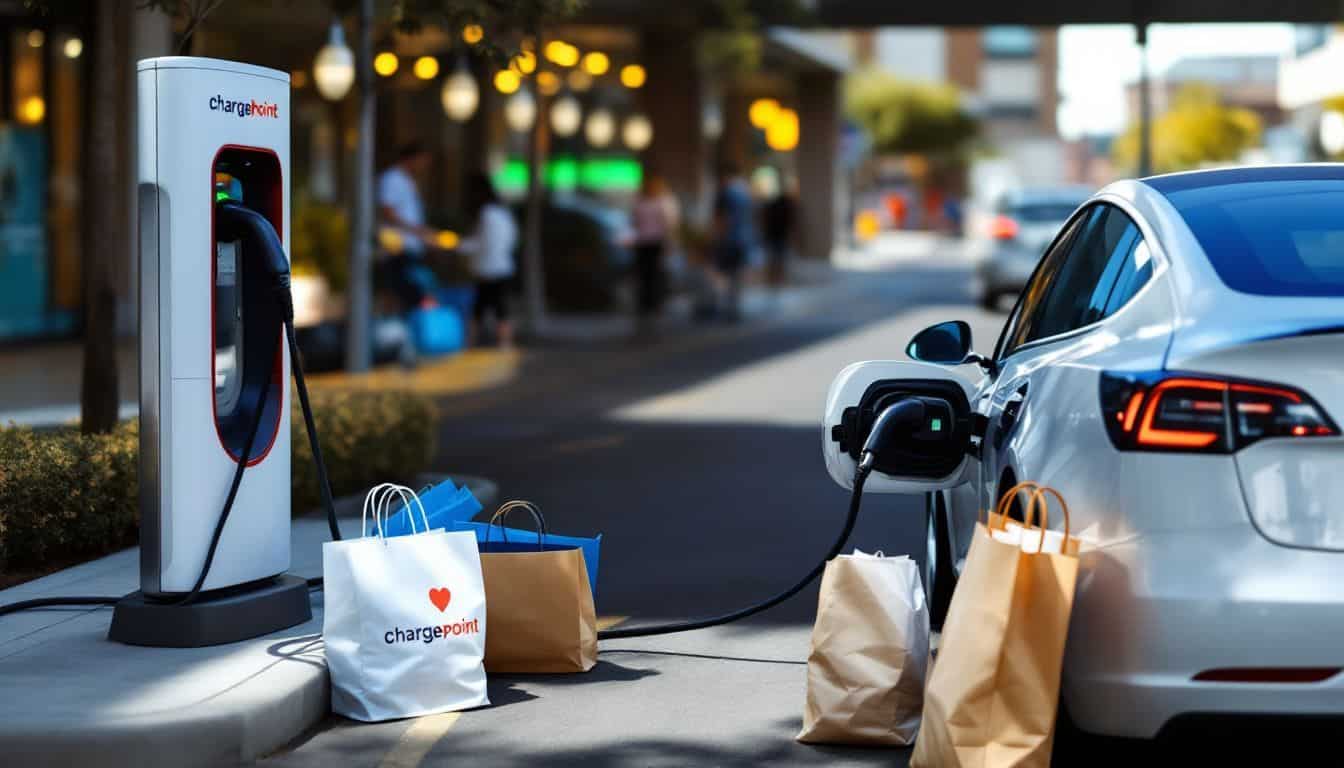
Tesla owners have more options than just Superchargers. Public networks like ChargePoint and Electrify America offer great alternatives. These stations pop up in handy spots – malls, parking lots, and even some workplaces.
It’s like finding a secret stash of power for your car!
Costs can vary, but some choices are wallet-friendly. A full charge for a Model 3 at Electrify America might set you back $15.50 to $21.50, depending on your state. But here’s a sweet deal – ChargePoint often lets Tesla drivers juice up for free.
That’s right, zero dollars!
Free charging is like finding a unicorn… but for your Tesla!
Analyzing the Costs to Charge a Tesla
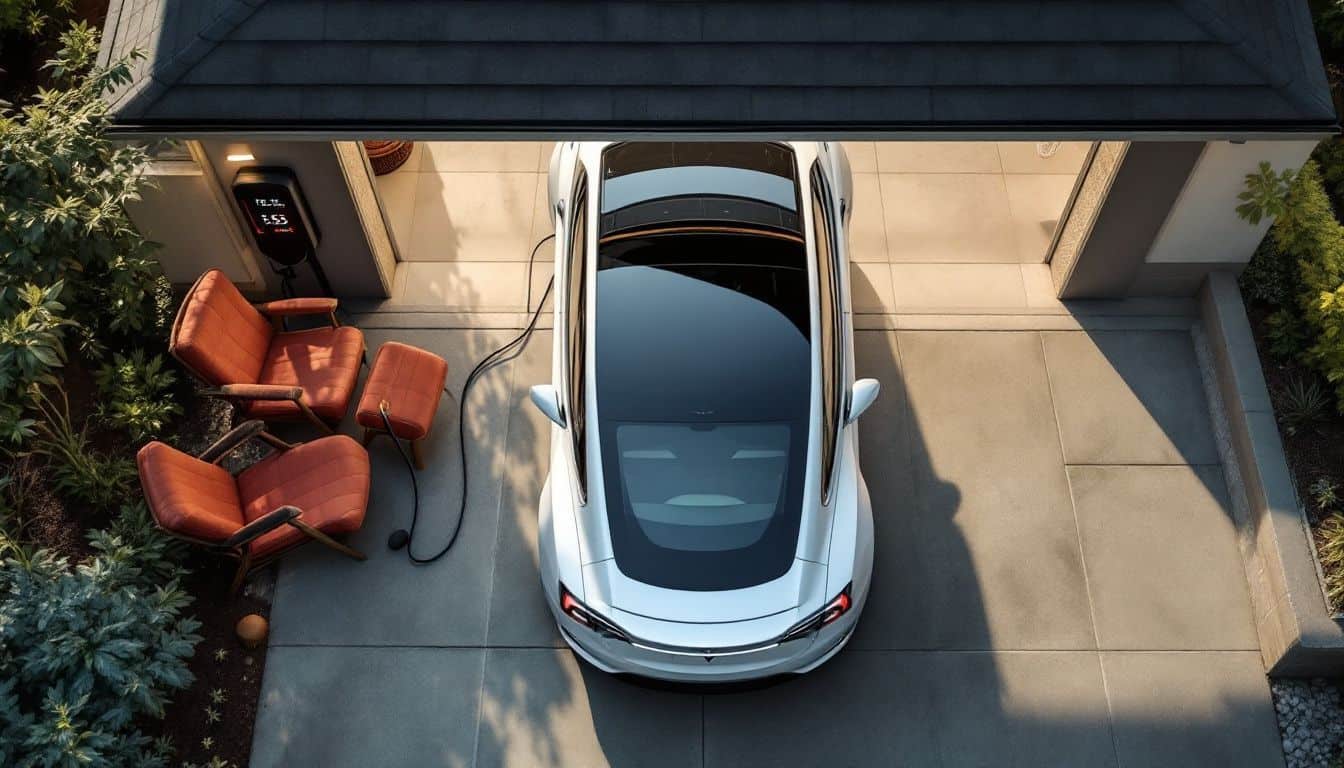
Let’s talk money – charging your Tesla isn’t free. But don’t worry, it’s not as scary as you might think!
Home Charging Expenses

Home charging is a wallet-friendly way to juice up your Tesla. It adds about $50 to your monthly power bill. That’s not too shabby! For a 60 kWh battery, you’ll shell out around $7.80 per full charge.
It’s like buying a fancy coffee… but for your car.
Your Tesla model affects your yearly energy costs. If you drive 40 miles daily, expect to pay:.
• Model S or Y: $653.76
• Model 3: $599.04
• Model X: $777.96
These costs make Teslas great family vehicles. Now, let’s zoom in on Tesla’s Supercharging Network….
Supercharger Pricing
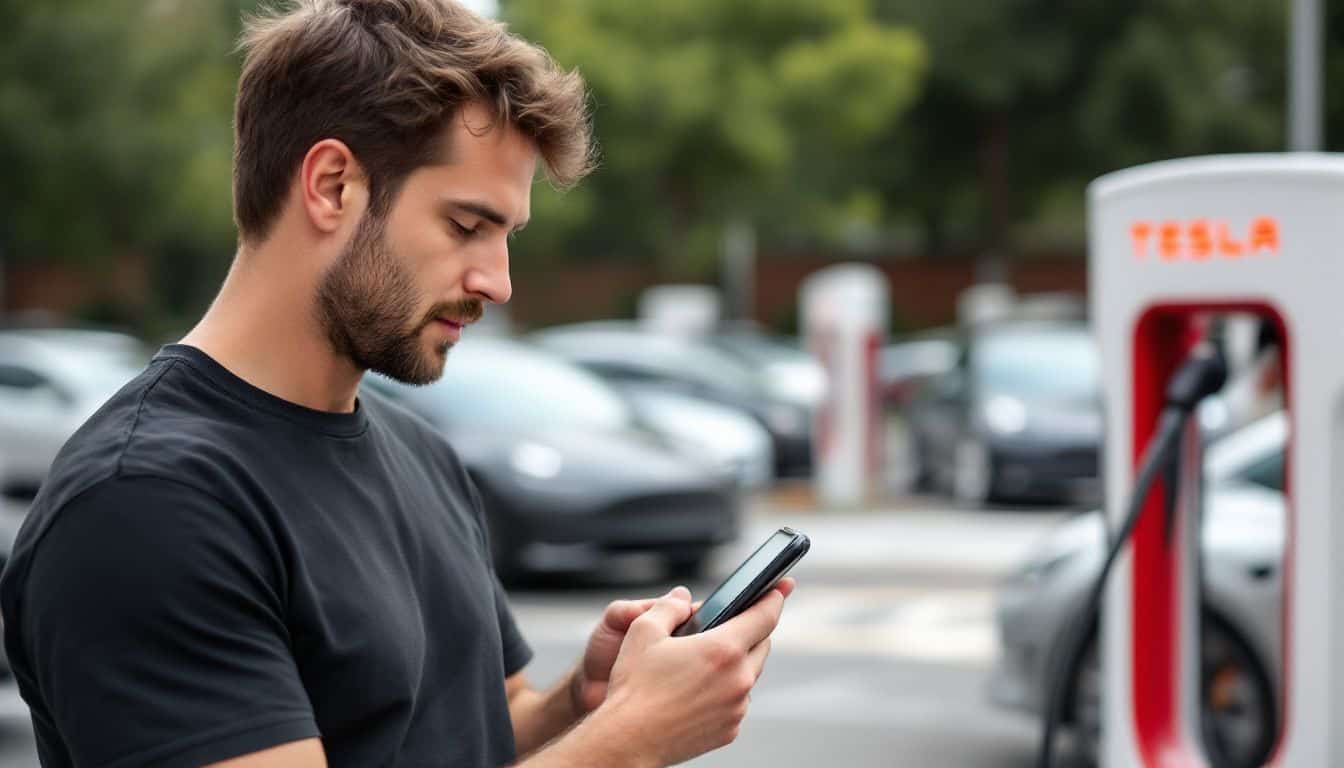
Tesla’s Supercharger network offers fast charging for road trips. Prices vary, but they’re usually higher than home charging. You’ll pay between $0.25 and $0.50 per kilowatt-hour at these stations.
That’s about twice the cost of juicing up at home. But it’s still cheaper than gas for most cars.
The cost to fill up your Tesla depends on where you are. In North Dakota, you might spend just $7 to charge a Model 3 from empty. But in Connecticut, the same charge could cost nearly $40.
Yikes! The Pacific Noncontiguous region has the highest rates overall. So, keep that in mind if you’re planning a cross-country Tesla adventure. Now, let’s look at some factors that affect these charging prices….
Costs at Public Charging Facilities
Public charging spots can cost more than home charging. Prices at these stations increased from 45 to 46 cents per kilowatt-hour between March and June 2024. It’s a small increase, but it adds up quickly.
For instance, charging a Tesla Model 3 Performance now costs about $35 at these locations.
Charging costs differ across the U.S. Some cities and states are less expensive than others. Also, be aware of “peak” pricing. Many power companies charge higher rates during busy hours, typically 4 PM to 9 PM.
It’s a good idea to schedule your charging outside these times if possible.
Timing is crucial for EV charging costs.
Factors That Affect Charging Prices

Charging your Tesla isn’t a one-size-fits-all deal. Prices can swing wildly based on when and where you juice up. Want to know the secrets to keep more cash in your pocket? Keep reading!
Variable Electricity Rates
Electricity rates can be a real rollercoaster ride. They go up and down based on when you use power. During busy times, like after work, rates climb. But late at night, they often drop.
This matters for Tesla owners. Charging your car when rates are low can save you big bucks.
Smart Tesla drivers keep an eye on these changing rates. They plug in their cars when electricity is cheap. This trick can cut charging costs by a lot. Some even use apps to track the best times to charge.
It’s like finding a sale at your favorite store – but for electricity! Next up, let’s look at how battery size affects your charging costs.
Battery Size and Capacity
Battery size matters big time for Tesla owners. Bigger batteries mean more miles on a single charge. The Model S packs a whopping 114 kWh battery, letting you cruise for 405 miles before needing a top-up.
That’s like driving from New York to Cleveland without stopping! On the flip side, the Model 3 RWD has a smaller 70 kWh battery, good for 272 miles. It’s still plenty for most daily drives and weekend getaways.
Your Tesla’s battery size affects how much you’ll pay to charge up. The Model X, with its 115 kWh battery, costs about $17.99 for a full charge. The Model Y Long Range, sporting a 91 kWh battery, is cheaper at $14.23.
But here’s the kicker – the Model 3 gives you the best bang for your buck at just 4.03 cents per mile. Talk about stretching your dollar! Next up, let’s look at how charge rates can impact your wallet.
A bigger battery is like having a larger gas tank – it lets you go further between fill-ups.
Charge Rate Impact
Charge rate impact plays a big role in Tesla charging costs. Fast charging, like at Superchargers, costs more than slow home charging. But it saves time. The trade-off? Higher prices for speed.
At home, a slower charge rate means lower electricity use and cheaper bills. It’s a balancing act between time and money.
Your Tesla’s battery size affects charge rates too. Bigger batteries take longer to fill up. This means more electricity use and higher costs. But they also give you more range. So while charging a Model S costs more than a Model 3, you’ll go further on that charge.
It’s all about finding what works for your lifestyle and budget.
Cost Comparison: Tesla Charging vs. Traditional Fueling

Charging a Tesla can save you big bucks compared to filling up a gas car. Let’s crunch some numbers and see how much green you’ll keep in your wallet by going electric.
Price Per Mile Breakdown
Let’s break down the cost per mile for Tesla vehicles. It’s interesting to see how electric cars compare to traditional gas vehicles. This table shows some revealing figures – it might change your perspective on your next car purchase!
| Vehicle Type | Cost per Mile |
|---|---|
| Tesla (Average) | 4.56 cents |
| Gas Vehicle (Average) | 13.73 cents |
| Tesla Model 3 RWD (Range) | 3 to 9 cents |
Pretty surprising, isn’t it? The contrast is clear. Tesla’s cost per mile is about a third of what you’d pay in a gas car. That’s a lot of savings! And here’s something cool – the Model 3 can go as low as 3 cents per mile. That’s cheaper than a stick of gum!
But there’s more… Annual energy costs for a Tesla Model 3 range from $405 to $1,215. Think about that compared to what you’re spending on gas now. It’s like getting extra money just by changing cars!
Keep in mind, these numbers can vary based on your location and driving habits. But one thing’s certain – Teslas are cost-effective in the long run. It’s great to see that being environmentally conscious can also be budget-friendly!
Annual Comparison of Fueling and Charging
Ladies, let’s talk money – specifically, how much you’ll save by switching to a Tesla. I’ve done the math, and the results might make you want to trade in your gas guzzler right away!
| Expense Type | Tesla (Annual Cost) | Gas Vehicle (Annual Cost) | Annual Savings with Tesla |
|---|---|---|---|
| Fuel/Charging | $614.95 | $1,850.42 | $1,235.47 |
| Home Charging vs. Refueling | Varies | N/A | Up to $2,000 |
Can you believe it? Tesla owners are laughing all the way to the bank, saving over $1,200 a year on fuel costs alone. That’s a new wardrobe or a fancy spa weekend!
But there’s more… If you’re smart about charging at home, you could pocket up to $2,000 extra per year. That’s not chump change, ladies!
I got my Tesla a while back. My wallet breathed a sigh of relief at the gas station. No more wincing at the pump – just plug in and save.
So, if you’re thinking about going electric, these numbers might convince you. Your bank account (and the planet) will thank you!
Tesla Vehicle Charging Requirements
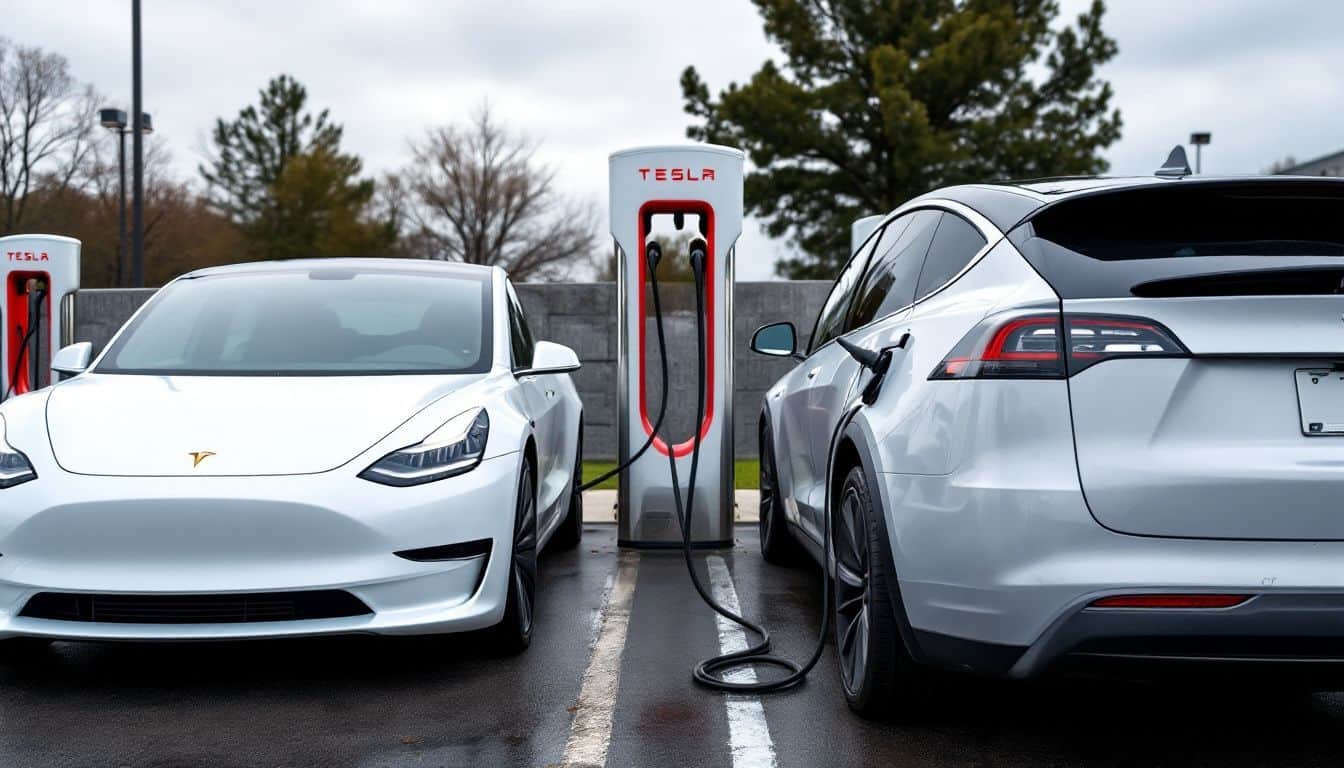
Tesla cars need different amounts of juice. Each model has its own charging quirks – from the zippy Model 3 to the beefy Model X. Let’s dive into what makes these electric beauties tick…
and charge!
Charging Needs of Tesla Model 3
Tesla Model 3 owners have different charging needs based on their car’s battery size. The RWD version has a 70 kWh battery that can go 272 miles on a full charge. It costs about $10.95 to fill up, which works out to 4.03 cents per mile.
The Long Range model packs more juice with its 86 kWh battery. This bad boy can cruise for 358 miles and costs $13.45 to charge fully – that’s just 3.76 cents per mile!
For speed demons, the Performance model boasts a 94 kWh battery. It’ll zip you along for 315 miles on a full tank… err, charge. Filling this beast up costs $14.70, coming in at 4.67 cents per mile.
But here’s the kicker – all Model 3s can use super-fast DC charging. They’ll juice up from 10% to 80% in just 27 minutes! That’s faster than you can say “road trip”!
Charging Needs of Tesla Model S
The Tesla Model S is an energy-hungry beast. It’s got a massive 114 kWh battery that can consume electricity like nobody’s business. To fill this power-hungry monster, you’ll need about $17.83 worth of juice.
But here’s the good news – that’ll take you a whopping 405 miles! That’s less than 5 cents per mile, which is pretty sweet when you think about it.
Charging this luxury sedan isn’t a one-size-fits-all situation. You’ve got options, ladies. At home, you can plug it in overnight and wake up to a full “tank.” Or, if you’re on a road trip, Tesla’s Supercharger network has got your back.
These fast chargers can fill your Model S with power in no time. Just keep in mind, charging costs may vary depending on where and when you juice up. But hey, that’s still way cheaper than filling up a gas guzzler!
Charging Needs of Tesla Model X
Tesla Model X owners, listen up! Your sleek electric SUV needs some juice. With its huge 115 kWh battery, you’ll get a whopping 348 miles on a full charge. That’s enough to zip from LA to Vegas and back! But here’s the kicker – filling up that big battery costs about $17.99.
Sounds pricey, right? Don’t worry! It breaks down to just 5.17 cents per mile. That’s way cheaper than gas!
Now, let’s talk charging time. At home, plugging into a regular outlet is like trying to fill a pool with a garden hose – slow-going. But with a Tesla wall charger, you’ll be back on the road in no time.
And if you’re on a road trip? Tesla’s Supercharger network has got your back. These fast chargers can juice up your Model X in about an hour. Next up, we’ll look at the charging needs of the sporty Tesla Model Y.
Charging Needs of Tesla Model Y
Moving from the Model X to the Model Y, let’s talk about this popular electric SUV. The Tesla Model Y Long Range needs about 91 kWh to fill up its battery. That’s enough juice to take you 330 miles! Pretty sweet, right?
Now, here’s the fun part – charging costs. At home, you’ll spend about $3.82 to drive 100 miles in your Model Y. But if you’re out and about using a Supercharger, it might cost you $10 to $19 for the same distance.
That’s still way cheaper than gas! Plus, you’re zipping around in a sleek, eco-friendly ride. Who says saving the planet can’t be stylish?
Tips to Save on Tesla Charging Costs

Want to save big on Tesla charging? We’ve got some nifty tricks up our sleeve… But you’ll have to stick around to find out! Trust me, these tips are worth their weight in gold – or should I say, kilowatt-hours?
Best Times to Charge
Charging your Tesla at the right time can save you big bucks. Let’s dive into the best times to juice up your electric ride:
- Late-night owl hours: Plug in between 11 PM and 5 AM. Demand plummets, and rates often drop by 30%.
- Weekend warriors: Many utilities offer lower rates on weekends. Take advantage of these slower days.
- Sunny side up: If you’ve got solar panels, mid-day charging is your golden ticket. Free energy from the sun? Yes, please!
- Off-peak paradise: Check with your power company for specific off-peak hours. They’re your new best friend.
- Early bird special: Some areas have lower rates in the early morning. Set your Tesla to charge just before you wake up.
- Avoid rush hour: Steer clear of charging between 4 PM and 9 PM. That’s when everyone’s using power, and prices soar.
- Holiday bonanza: Some utilities offer special rates on holidays. It’s like a gift for your wallet.
- Weather watch: On mild days, power demand drops. Keep an eye on the forecast for unexpected charging deals.
Using Solar Energy for Charging
Solar power can be a game-changer for Tesla owners. It’s like having your own mini power plant right at home! You’ll need about 8 to 10 extra solar panels to juice up your Tesla. The cost? It ranges from $9.62 to $18.30 per charge.
That’s pretty sweet compared to regular electricity rates.
But here’s the kicker – setting up a solar system for your Tesla isn’t cheap. You’re looking at around $21,978 upfront. Ouch! Still, it’s an investment that pays off over time. You’ll slash your long-term electricity costs and feel good about using clean energy.
Plus, imagine never having to worry about power outages or rising utility bills again. It’s like giving your wallet and Mother Earth a big ol’ hug at the same time!
Frequently Asked Questions on Tesla Charging
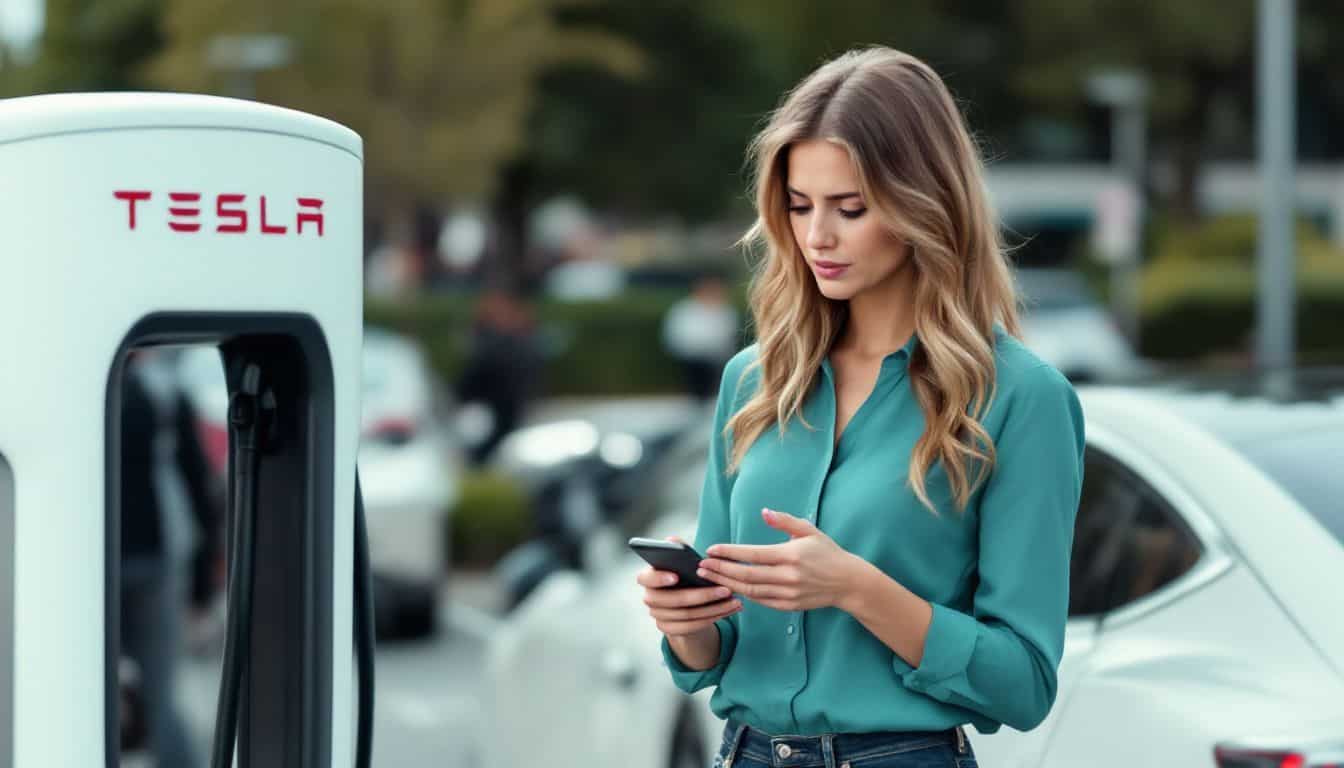
Got burning questions about Tesla charging? We’ve got answers! From charging times to free spots, we’ll zap away your worries… Keep reading to power up your EV knowledge!
Duration Needed to Charge a Tesla
Charging a Tesla isn’t a one-size-fits-all deal. At home, you’ll need about 8 to 10 hours for a full charge. That’s perfect for overnight juice-ups while you catch some Z’s. But if you’re on the go, Tesla’s got your back with their Superchargers.
These bad boys can zap up to 200 miles of range into your ride in just 15 minutes! Talk about a quick pit stop.
For the speed demons out there, let’s talk Model S Plaid. This beauty took 51 minutes to charge from 5% to 95% using a V3 Supercharger. That’s less time than it takes to binge-watch your favorite TV show! Next up, we’ll dive into where you can charge your Tesla without spending a dime.
Spoiler alert: free charging spots do exist!
Locations to Charge a Tesla at No Cost
Free Tesla charging spots are out there – you just need to know where to look! Many hotels and restaurants offer complimentary charging for guests. It’s a smart way to attract customers while they juice up.
Some workplaces have also jumped on the free-charge bandwagon. Lucky employees can plug in during the 9-to-5 grind. And don’t forget about those sneaky mall parking lots. Some shopping centers let you charge for free while you browse.
But here’s the real scoop – Tesla’s Destination Charging program is a goldmine. Over 40,000 Wall Connectors are sprinkled across hotels, resorts, and eateries. Most of these spots let you charge at no cost if you’re a paying customer.
It’s like getting a free tank of gas with your burger! Now, let’s dive into the nitty-gritty of how much it typically costs to charge up your Tesla.
Cost Comparison: Tesla Charging vs. Gas Usage
Ladies, let’s talk money! Ever wonder how much you’re really saving with a Tesla? Here’s the scoop on charging costs versus filling up at the pump.
| Tesla Charging | Gas Usage |
|---|---|
| Average annual cost: $485 | Average annual cost: $1,117 |
| Cost per mile: 3-4 cents | Cost per mile: 10-15 cents |
| 7-year savings: $7,000 to $11,000 | 7-year extra cost: $7,000 to $11,000 |
| Home charging: Cheapest option | Gas station: Only option |
| Supercharger: Fast but pricier | Premium gas: Costly for high-end cars |
Wow, right? The numbers don’t lie. Teslas are way cheaper to “fuel” than gas cars. You’ll save a bundle in the long run. Think about it – that’s extra cash for shoes, girls’ nights out, or that dream vacation!
But here’s the kicker… It’s not just about saving money. You’re also doing your bit for Mother Earth. Less pollution, cleaner air – it’s a win-win! And let’s be real, there’s something pretty cool about never having to stop at a gas station again.
So, next time you’re cruising in your Tesla, give yourself a pat on the back. You’re not just driving in style – you’re driving smart!
References
https://www.motortrend.com/features/home-ev-charging-installation-guide/
https://www.tesla.com/support/charging/home-charging
https://electrek.co/guides/tesla-supercharger/
https://www.solarreviews.com/blog/how-do-tesla-chargers-compare-to-other-electric-car-chargers
https://www.tesla.com/support/charging
https://www.wsj.com/tech/ev-home-charging-i-saved-hundreds-of-dollars-d082870c (2024-03-27)
https://www.motortrend.com/features/how-much-does-it-cost-to-charge-a-tesla/
https://www.wired.com/story/how-much-will-it-cost-to-charge-my-electric-car-its-complicated/ (2024-08-22)
https://www.ncbi.nlm.nih.gov/pmc/articles/PMC9070358/
https://www.energysage.com/ev-charging/electric-vehicle-charging-cost/tesla-charging-cost-vs-gas/ (2024-07-31)
https://8msolar.com/cost-of-charging-each-tesla-ev-model/
https://evbox.com/en/electric-cars/tesla/tesla-model-3
https://evbox.com/en/electric-cars/tesla/tesla-model-y
https://teslamotorsclub.com/tmc/threads/charging-times-it-helps.309532/ (2023-08-17)
https://www.cleanenergyreviews.info/blog/solar-ev-charging
https://www.motortrend.com/features/how-long-does-it-take-to-charge-a-tesla/
https://www.nrdc.org/stories/electric-vs-gas-cars-it-cheaper-drive-ev (2024-03-21)
